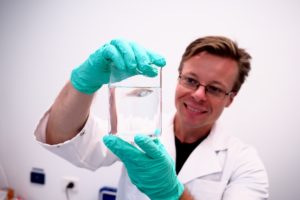New Griffith research is using biochemical profiles from the blood of sea turtles as a tool to monitor the health of populations in the wild.
Published in Comparative Biochemistry and Physiology, the researchers used metabolomics, which measures the by-products of physiological processes, to determine if environmental conditions or the way in which they were captured can affect their health.
“As iconic but threatened species, there is considerable interest in adapting cutting-edge analytical techniques to evaluate the health of wild populations of sea turtles,” said Dr Steve Melvin a Research Fellow at the Australian Rivers Institute.
“Nuclear magnetic resonance spectroscopy is a powerful technique that can provide a metabolic fingerprint of the physiological processes taking place in an animal. It gives a direct indication of an organism’s health and how external conditions influence an animal’s physiological response.
“Being non-lethal, metabolomics provides an attractive method for comparing populations of threatened species like sea turtles, and to understand how the environment they are living in impacts their health. However, few studies have used this method to evaluate wild populations of sea turtles.”

Dr Steve Melvin a Research Fellow at the Australian Rivers Institute
This study is the first of its kind to compare the biochemical profiles of both resting and active turtles from coastal and reef locations, sampled across multiple seasons in Southeast Queensland.
“Our results show clear differences in the chemical fingerprints of turtles living in different locations, which can be attributed to varying diet or forage quality and potentially differing levels of exposure to stressors like chemical contaminants between coastal and reef sites,” Dr Melvin said.
“We also observed clear markers of physical exertion in animals captured while active, using a method called the ‘rodeo’ technique, which were absent in turtles sampled while resting.”
Turtles sampled from one location over an 8-month period had only modest differences in the metabolome over time, suggesting the technique is flexible and not prone to confounding factors.
“When evaluating the health of sea turtles, or other marine creatures in the wild, site characteristics like the quality of an animals’ food source, the amount of pollution and whether they are resting vs active appear to have a far bigger influence on turtle physiology than the effect of seasonal changes,” Dr Melvin said.
“Our study offers a real-world example of how an untargeted metabolomic technique, which provides a non-invasive snapshot of physiological health, can contribute towards the monitoring and management of sea turtle populations and serves as an example for the monitoring of other marine megafauna species across large areas and time scales in the wild.”
